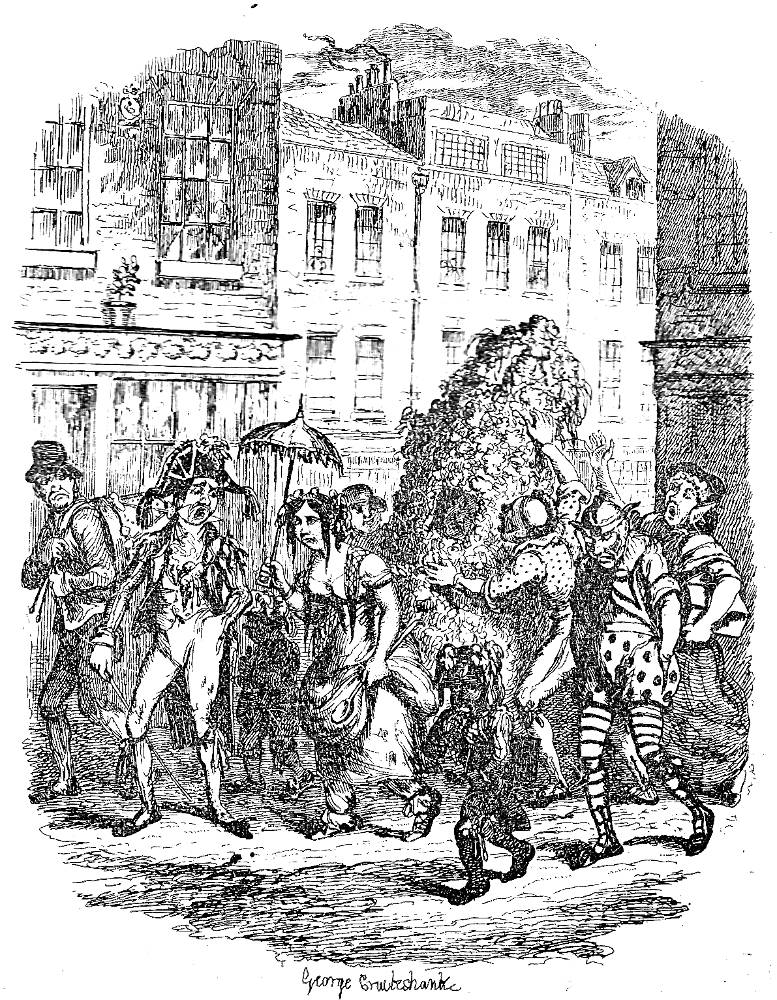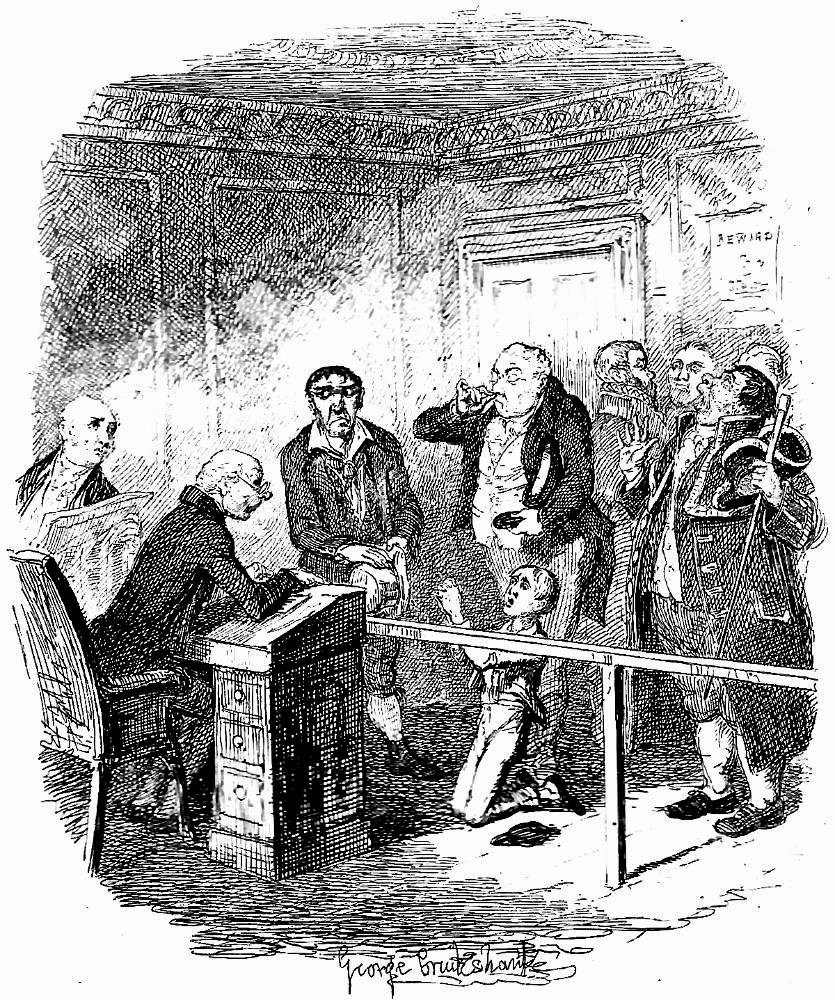
The First of May by Arthur B. Frost for "Scenes: Chapter XX," in Dickens's Sketches by Boz Illustrative of Every-day Life and Every-Day People, facing page 87. Wood-engraving; 5 ⅛ by 7 ⅝ inches (12.9 cm high by 19.5 cm wide), framed.
Scanned image, colour correction, sizing, caption, and commentary by Philip V. Allingham. [You may use this image without prior permission for any scholarly or educational purpose, as long as you (1) credit the person who scanned the image, and (2) link your document to this URL in a web document or cite the Victorian Web in a print one.]
Bibliographical Information
Originally published as "A Little Talk about Spring and Sweeps" in Chapman and Hall's Library of Fiction, No. 3 (1836), the seasonal sketch appeared in the second series of Sketches by Boz (1839). This piece was not one of Dickens's journalistic sketches, but was placed in the "Scenes" section of Sketches by Boz in the 1839 edition, which it seems likely Frost had seen. The 1876 and 1877 Household Editions of Dickens's Sketches by Boz, Illustrative of Every-day Life and Every-Day People each contain a single wood-engraving of the sweeps in their May Day pageant, probably modelled in part on the original Cruikshank copper-plate engraving.
Passage Illustrated: A Decaying Ritual Enacted
Judge of our virtuous indignation, when the street-door of the shed opened, and a party emerged therefrom, clad in the costume and emulating the appearance, of May-day sweeps!
The first person who appeared was "my lord," habited in a blue coat and bright buttons, with gilt paper tacked over the seams, yellow knee-breeches, pink cotton stockings, and shoes; a cocked hat, ornamented with shreds of various-coloured paper, on his head, a bouquet the size of a prize cauliflower in his button-hole, a long Belcher handkerchief in his right hand, and a thin cane in his left. A murmur of applause ran through the crowd (which was chiefly composed of his lordship’s personal friends), when this graceful figure made his appearance, which swelled into a burst of applause as his fair partner in the dance bounded forth to join him. Her ladyship was attired in pink crape over bed-furniture, with a low body and short sleeves. The symmetry of her ankles was partially concealed by a very perceptible pair of frilled trousers; and the inconvenience which might have resulted from the circumstance of her white satin shoes being a few sizes too large, was obviated by their being firmly attached to her legs with strong tape sandals.
Her head was ornamented with a profusion of artificial flowers; and in her hand she bore a large brass ladle, wherein to receive what she figuratively denominated "the tin." The other characters were a young gentleman in girl's clothes and a widow’s cap; two clowns who walked upon their hands in the mud, to the immeasurable delight of all the spectators; a man with a drum; another man with a flageolet; a dirty woman in a large shawl, with a box under her arm for the money, — and last, though not least, the "green," animated by no less a personage than our identical friend in the tarpaulin suit.
The man hammered away at the drum, the flageolet squeaked, the shovels rattled, the "green" rolled about, pitching first on one side and then on the other; my lady threw her right foot over her left ankle, and her left foot over her right ankle, alternately; my lord ran a few paces forward, and butted at the "green," and then a few paces backward upon the toes of the crowd, and then went to the right, and then to the left, and then dodged my lady round the "green;" and finally drew her arm through his, and called upon the boys to shout, which they did lustily — for this was the dancing.
We passed the same group, accidentally, in the evening. We never saw a "green" so drunk, a lord so quarrelsome (no: not even in the house of peers after dinner), a pair of clowns so melancholy, a lady so muddy, or a party so miserable.
How has May-day decayed! ["Scenes," Chapter XX, "The First of May," page 155]
Commentary: A British Street Festival

Having had no experience of the London streets when he completed this series for the Harper and Brothers Household Edition in 1876, A. B. Frost could not draw his celebration of chimney-sweeps from life, and accordingly fell back on the only model readily available to him, George Cruikshank's The First of May — for the twentieth chapter in "Scenes" by Charles Dickens in Sketches by Boz (1836). Frost's figures, although more realistic and less caricatural, are comparable to Cruikshank's in their costumes and juxtapositions in Cruikshank's eighteenth engraving for "Scenes."
By the expressions of Frost's celebrants, nobody is enjoying himself. And in the March 1837 instalment of Oliver Twist Dickens had exposed the practice of letting orphans and foundlings out as chimney sweeps. Rochester, Kent, near Dickens's mansion of Gadshill Place, still celebrates the 1st of May in the way described here. However, when the Climbing Boys' Act 1868 forbade the employment of boys as sweeps because it was an egregious and dangerous example of exploitative child labour, the traditional first of May procession faded quickly in most English cities, leaving as its vestige the Morris Dance.
Relevant Illustrations of the Sweep in this Period


Left: George Cruikshank's realisation of the sweep's pleading his case before the Guardians of the Workhouse, Oliver escapes being bound apprentice to the Sweep (1837). Right: John Leighton's exposé of the use of foundlings as sweeps, The Foundling Hospital — Sweep! — Soot Oh! (1847).
Bibliography
Ackroyd, Peter. Dickens: A Biography. London: Sinclair-Stevenson, 1990.
Barnard, J. "Fred" (il.). Charles Dickens's Sketches by Boz, with thirty-four illustrations. The Works of Charles Dickens: The Household Edition. 22 vols. London: Chapman and Hall, 1876. Volume 13.
Barnard, Fred, et al. Scenes and Characters from Dickens. London: Chapman & Hall, 1908.
Bentley, Nicolas, Michael Slater, and Nina Burgis. The Dickens Index. New York and Oxford: Oxford U. P., 1990.
Davis, Paul. Charles Dickens A to Z: The Essential Reference to His Life and Work. New York: Checkmark and Facts On File, 1999.
Dickens, Charles. Oliver Twist. Il. George Cruikshank. London: Bradbury and Evans; Chapman and Hall, 1846.
Dickens, Charles. "Scenes," Chapter 20, "The First of May," Sketches by Boz. Illustrated by George Cruikshank. London: Chapman and Hall, 1839; rpt., 1890. Pp. 125-30.
Dickens, Charles. "Scenes," Chapter 20, "The First of May," Christmas Books and Sketches by Boz, Illustrative of Every-day Life and Every-day People. Illustrated by Sol Eytinge, Jr. The Diamond Edition. Boston: James R. Osgood, 1875 [rpt. of 1867 Ticknor & Fields edition]. Pp. 320-24.
Dickens, Charles. "Scenes," Chapter 20, "The First of May," Sketches by Boz. Illustrated by Fred Barnard. The Household Edition. London: Chapman and Hall, 1876. Pp. 79-83.
Dickens, Charles. "Scenes," Chapter 20, "The First of May," Sketches by Boz. Illustrated by Harry Furniss. The Charles Dickens Library Edition. London: Educational Book Company, 1910. I, 160-67.
Dickens, Charles. Sketches by Boz. Illustrated by George Cruikshank. London: Chapman & Hall, 1836.
Dickens, Charles. Sketches by Boz. Illustrated by F. O. C. Darley and John Gilbert. The Works of Charles Dickens. The Household Edition. 55 vols. New York: Sheldon and Company, 1864. Vols. 1-2.
Dickens, Charles. Sketches by Boz. Illustrated by Harry Furniss. The Charles Dickens Library Edition. 18 vols. London: Educational Book, 1910. Vol. 1.
Dickens, Charles. Pictures from Italy, Sketches by Boz and American Notes. Illustrated by Thomas Nast and Arthur B. Frost. New York: Harper & Brothers, 1877 (copyrighted in 1876).
Dickens, Charles, and Fred Barnard. The Dickens Souvenir Book. London: Chapman & Hall, 1912.
Hawksley, Lucinda Dickens. Chapter 3, "Sketches by Boz." Dickens Bicentenary 1812-2012: Charles Dickens. San Rafael, California: Insight, 2011. Pp. 12-15.
Limner, Luke [John Leighton]. The Cries of London & Public Edifices from Sketches on the Spot. London: Grant & Griffith successors to Newberry and Harris. Corner of St Paul's Church Yard, [1847]. Internet Archive version of a copy in the University of Toronto Library. Web. 17 September 2013.
Slater, Michael. Charles Dickens: A Life Defined by Writing. New Haven and London: Yale U. P., 2009.
Last modified 2 June 2019